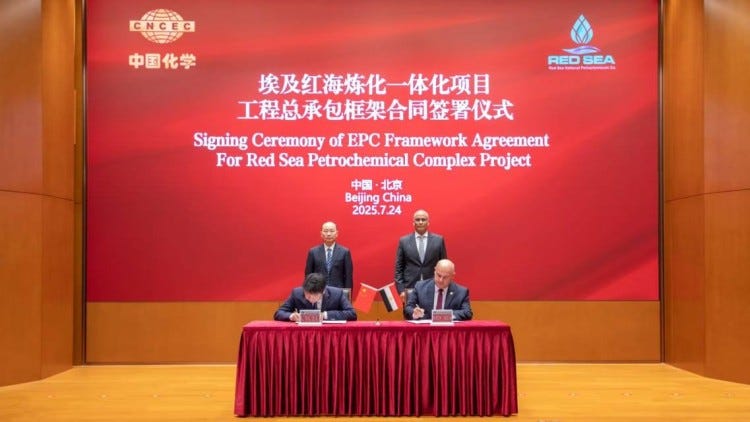China-Egypt Petrochemical Deal: Win Amid US Trade Falters
Beijing’s ability to capitalise on US trade policies is positioning it as the primary beneficiary.
Egypt’s Red Sea National Petrochemicals Company and China National Chemical Engineering Company (CNCEC) have signed what the Ministry of Petroleum and Mineral Resources has called “one of Egypt’s most prominent future projects in the chemical industries sector”: an unbinding framework agreement for the implementation of the Red Sea Petrochemical Project in the Suez Canal Economic Zone (SCZONE). The $1.7 billion initiative marks a key step in Egypt’s industrial ambitions and China’s growing role in critical resource markets amid Trump’s ongoing tariff policies, which appear to be pushing countries closer to China.
Cairo Wins, China Wins
The Red Sea Petrochemical Project is central to Egypt’s Vision 2030, focusing on economic diversification and industrial self-sufficiency. Strategically positioned near the Suez Canal and Ain Sokhna Port, it targets export markets across Europe, Asia, and Africa by producing high-demand petrochemicals such as polyethylene and propylene through advanced refining and steam cracking technologies. By localising production, Egypt aims to reduce import dependency, boost exports, and create significant employment, supporting its ambition to become a regional petrochemical hub. Key advantages include licensed production units and CNCEC’s potential to finance up to 85% of the EPC contract, which enhance its investment appeal by reducing financial risks and expediting development.
The agreement bolsters Beijing’s hold on African and Middle Eastern critical mineral and petrochemical supply chains. CNCEC’s involvement, along with three other contracts worth nearly $1 billion for soda ash, silicon, and bioethanol projects, highlights China’s technical expertise and capital as key tools for strengthening economic ties with resource-rich nations. This new partnership positions China to secure access to Egypt’s petrochemical output, diversifying its supply chains amid rising global demand.
Washington’s Policies Backfire
Crucially, the deal serves as a geopolitical countermove to Trump’s tariff threats, which have pushed other countries closer to Beijing. Most recently with Trump's additional 25% tariff on India, making the total punishment on the US ally at 50%; shortly after the announcement Prime Minister Modi announced a visit to Beijing and the upcoming Shanghai Cooperation Organisation summit in Tianjin, marking his first trip to China in over seven years.
By aligning with Egypt, China mitigates potential US trade disruptions, securing stable access to critical materials and reinforcing its position as a reliable partner for developing nations cautious of Western economic pressures. Moreover, this alignment reflects Cairo’s strategic move to leverage its BRICS engagement amid growing uncertainty from Washington.
India’s pivot towards closer ties with China, spurred by Trump’s tariff policies, amplifies the deal’s significance. As India faces potential economic isolation, its warming relations with Beijing suggest China could use Egypt’s project to integrate India into its broader supply chain network, potentially as a market for petrochemical exports or a partner in regional industrial initiatives. This realignment highlights China’s growing ability to capitalise on US trade policies, increasingly positioning itself as the primary beneficiary.




